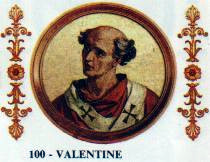
Pope Agapetus II was Pope from 10 May 946 to his death in 955. A nominee of the Princeps of Rome, Alberic II, his pontificate occurred during the period known as the Saeculum obscurum.

Pope Honorius II, born Lamberto Scannabecchi, was Pope from 21 December 1124 to his death in 1130.

Pope Gregory IV was Bishop of Rome and ruler of the Papal States from October 827 to his death in 844. His pontificate was notable for the papacy’s attempts to intervene in the quarrels between the emperor Louis the Pious and his sons. It also saw the breakup of the Carolingian Empire in 843.

Pope Stephen III was Bishop of Rome and ruler of the Papal States from 7 August 768 to his death in 772.

Pope Stephen IV was Bishop of Rome and ruler of the Papal States from June 816 to his death in 817.

Pope Sergius III was Pope from 29 January 904 to his death in 911. He was pope during a period of feudal violence and disorder in central Italy, when warring aristocratic factions sought to use the material and military resources of the Papacy. Because Sergius III had reputedly ordered the murder of his two immediate predecessors, Leo V and Christopher, and allegedly fathered an illegitimate son who later became pope, his pontificate has been variously described as "dismal and disgraceful", and "efficient and ruthless".

Pope Valentine was Bishop of Rome and ruler of the Papal States for two months in 827.

Pope Leo VIII was the head of the Catholic Church from 23 June 964 to his death in 965; An appointee of the Holy Roman Emperor, Otto I, his pontificate occurred during the period known as the Saeculum obscurum.

Pope John XIII was Pope from 1 October 965 to his death in 972. His pontificate was caught up in the continuing conflict between the Emperor, Otto I, and the Roman nobility.

Pope John X was Pope from March 914 to his death in 928. A candidate of the Counts of Tusculum, he attempted to unify Italy under the leadership of Berengar of Friuli, and was instrumental in the defeat of the Saracens at the Battle of Garigliano. He eventually fell out with Marozia, who had him deposed, imprisoned, and finally murdered. John’s pontificate occurred during the period known as the Saeculum obscurum.
Antipope Constantine II was an antipope for over a year, from 28 June 767 to 6 August 768. He was overthrown through the intervention of the Lombards and tortured before he was condemned and expelled from the Church during the Lateran Council of 769.
The Roman Canon is the oldest eucharistic prayer used in the Mass of the Roman Rite, and dates its arrangement to at least the 7th century. Through the centuries, the Roman Canon has undergone minor alterations and modifications, but retains the same essential form it took in the seventh century under Pope Gregory I. Before 1970, it was the only eucharistic prayer used in the Roman Missal, but since then three other eucharistic prayers were newly composed for the Mass of Paul VI.
The Synod of Rome may refer to a number of synods or councils of the Roman Catholic Church, held in Rome.

The history of Eastern Orthodox Christian theology begins with the life of Jesus and the forming of the Christian Church. Major events include the Chalcedonian schism with the Oriental Orthodox miaphysites, the Iconoclast controversy, the Photian schism, the Great Schism between East and West, and the Hesychast controversy. The period after the Second World War saw a re-engagement with the Greek, and more recently Syriac, Fathers that included a rediscovery of the theological works of St. Gregory Palamas, which has resulted in a renewal of Orthodox theology in the 20th and 21st centuries.
The Synod of Rome (721) was a synod held in St. Peter’s Basilica under the authority of Pope Gregory II to establish canons to improve church discipline.
The Synods of Rome in 731 were two synods held in St. Peter’s Basilica in the year 731 under the authority of Pope Gregory III to defend the practice of Icon veneration.
The Synod of Rome (964) was a synod held in St. Peter’s Basilica from 26 to 28 February 964, for the purpose of condemning the Synod of Rome (963) and to depose Pope Leo VIII.















